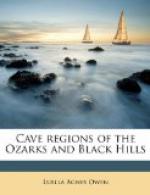Within the cabin the immediate entrance to the cave is securely closed, and in order that the door may not be forced from its fastenings by the roaring wind which shakes it threateningly, it opens in, instead of out. This wind suggested the name Wind Cave, and will probably be utilized, at no very distant time, to generate electricity for lighting the cavern.
The wind is strongest at the surface, and a guide goes down first to place lights in sheltered nooks where the force has begun to diminish, about fifty feet below the entrance; and here we light our candles which, if guarded somewhat, are not extinguished unless the current is unusually severe. The balance of the descent of one hundred and fifty-five feet from the surface to the first chamber is easily accomplished.
This would be the least interesting room in the cave if it were not the Bride’s Chamber, on account of having once been the scene of a marriage ceremony. But no others are in need of assistance of such romantic nature, as all are curiously and handsomely decorated, with such a charming variety of deposits, artistically massed, combined or contrasted, that every step brings fresh pleasure, and monotony is nowhere.
Passing from this room by a long, narrow passage, in the walls of which are observed many beautiful little pockets of crystals, attention is presently called to Lincoln’s Fireplace, a perfectly natural specimen of the old-fashioned design broadly open in the chimney; doubtless just such an one as Mr. Lincoln’s good mother hung the crane in and set the Dutch oven before. A little beyond and on the opposite side of the crevice is Prairie-dog town, not a very extensive town, to be sure, but so true a copy that one unfamiliar with the small animal and his style of architecture would afterwards easily recognize both. At one time his dogship was carried away by a too eager collector, but a letter to the suspected visitor brought him home by the next freight.
The Dutch Clock occupies a position on a shelf near by, and all southern visitors greet the Alligator as a familiar friend, as all of us joyfully meet any acquaintance from home.
A long narrow passage, formerly a “tight crawl,” but later opened up by heavy blasting, must be traversed before we come to the Snow Ball Room, beautiful with round spots of untinted carbonate of lime, as if fresh soft snow had been thrown by the handful over walls and ceilings, with the additional ornamentation of calcite crystals. In the crevice beyond rises the Church Steeple, diminishing regularly, though roughly, in size, to a height of sixty feet, but not degraded with the little squirming stairway usually seen in Church spires.




